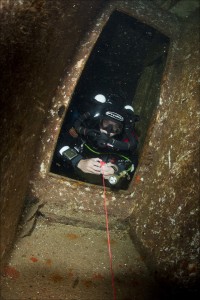News
Tech Diving in Malta and Gozo
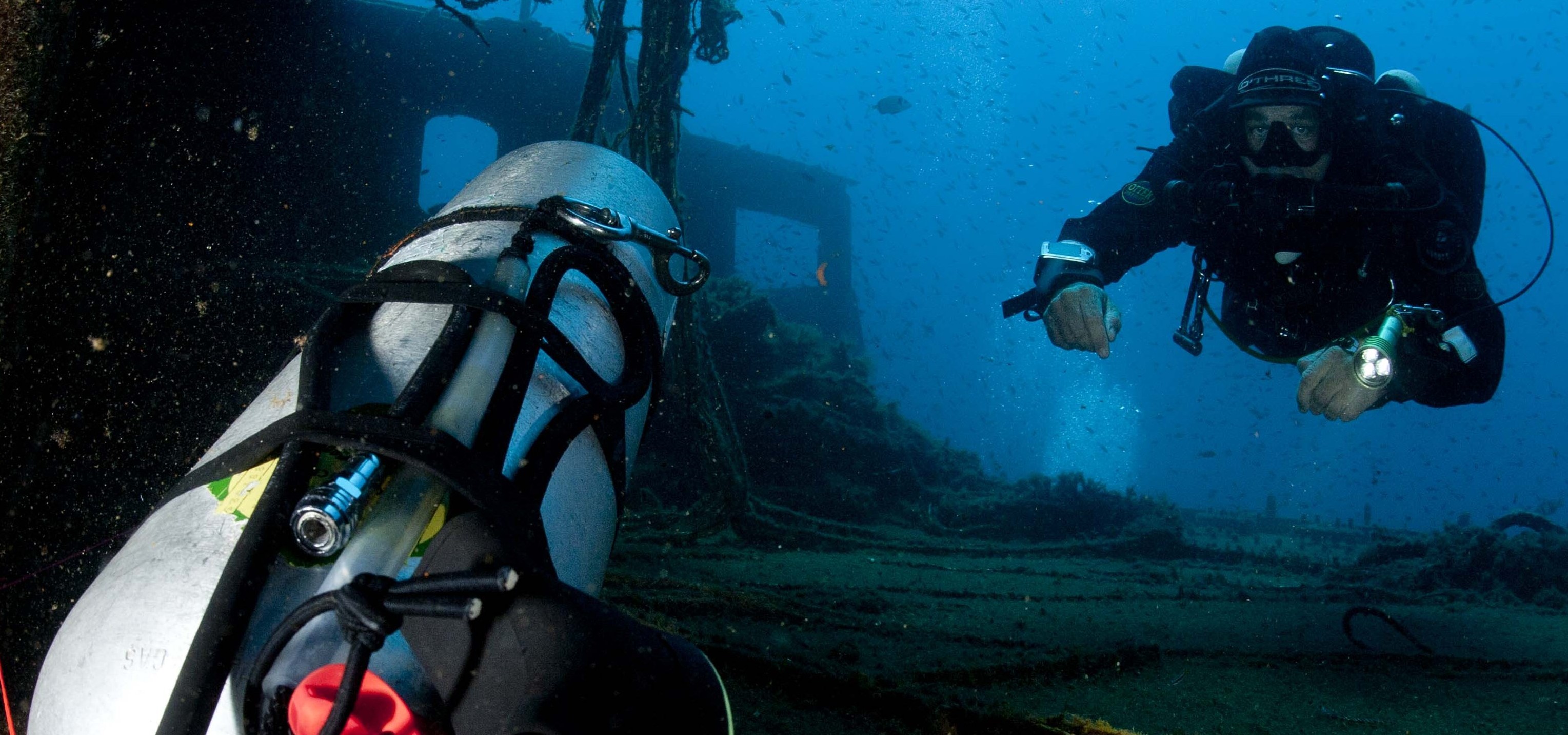
Tech diving; it conjures up images of extreme depth, no colours, torches the size of light houses and quite simply, bugger all to see!!!
Well, I’m a tech instructor and proud of it (I am by the way also a RAID Recreational Instructor Trainer and I love teaching recreational too)!
Yes, we are the equivalent of train spotters in the dive industry; however, we rock!!!
We go deeper, get wetter for longer and let’s face it, it’s not really that difficult. And my God it’s so much fun.
I have been cave diving in Mexico, rebreather diving in the Maldives and deep diving in the Red Sea. However, what I want to tell you about in this article is the tech diving I’ve done in Malta and Gozo.
Only three hours away, with flights from just about every major city in England including Gatwick, Heathrow and Stansted, not only is it easy to get to, but the Maltese Government and their own airline, Air Malta, realise how important divers are to their economy; wait for this… you get an extra 15 to 20 kilos for dive kit. Now that is awesome if you happen to be diving with 2 regulators on your back, 2 Oxygen regulators attached to your stage cylinders, a wing BCD and steel back plate, two surface marker buoys, two reels, two computers, two slates, lights, suit, boots, fins…oh, and two masks for good luck.
So enough about all that, let’s get down to the diving.
The first site we dived, called Inland Sea, was a perfect Decompression (45 metre max) stroke Extended Range (55 metre max) dive. The entry here is relatively easy for divers wearing twin sets as there is a slipway into the water where the stages can be left so they can be donned easily once you’re in the water.
It’s a beautiful site; the descent is made into a huge tunnel through a mountain connecting the inland sea to the real (!) sea. Once under the water you are met with the most wonderful view of a huge cavern; the rock structures make you feel like you are in a cave, when actually it’s totally open above your head. The viz here is awesome.
In terms of doing a full blown tech dive it has it all – the bottom phase of the dive is done hovering over huge boulders and you can easily get 55 metres here. The decompression phase is really great as you can re-enter the entrance to the tunnel and decompress while observing the rock formations silhouetted against the light filtering through this huge cavern.
The second site was the Blue Hole. Accessing the Blue Hole itself is really quite challenging – there is quite a walk down a steep rocky incline and you really have to work as a team so as not to get into any bother. I have done this dive a few times now and I can tell you this makes you realise how unfit you actually are. Adam, one of my team, managed to perspire an entire can of Lynx here!!!
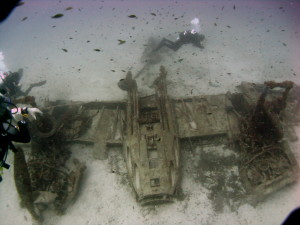 Once you are in the water though, you realise why you went to all the bother. There are two ways to do this dive. One is to go through Coral Garden, which is stunning; shelves of rocks and overhangs everywhere and unbelievably for the Med, masses of fish. Again the bottom phase is all rock structures but the deco phase is bloody fantastic. Certain stops can be done in some of the caverns that abound on the Maltese Islands and then the final deco phase can be done in the blue hole itself, which is awe inspiring. It is reasonably small as far as Blue Holes go but it’s visually stimulating, and gazing up at the surface and seeing other divers in all their tech gear hovering in the water silhouetted against the outline of the hole is breathtaking. The other way to do this dive is to enter through the Blue Hole and make your way round to the entrance to the Inland Sea and deco in there as per the previous dive.
Once you are in the water though, you realise why you went to all the bother. There are two ways to do this dive. One is to go through Coral Garden, which is stunning; shelves of rocks and overhangs everywhere and unbelievably for the Med, masses of fish. Again the bottom phase is all rock structures but the deco phase is bloody fantastic. Certain stops can be done in some of the caverns that abound on the Maltese Islands and then the final deco phase can be done in the blue hole itself, which is awe inspiring. It is reasonably small as far as Blue Holes go but it’s visually stimulating, and gazing up at the surface and seeing other divers in all their tech gear hovering in the water silhouetted against the outline of the hole is breathtaking. The other way to do this dive is to enter through the Blue Hole and make your way round to the entrance to the Inland Sea and deco in there as per the previous dive.
There are many other incredible dives on Gozo in this depth range but these two were my favourites.
After doing some really cool deep air dives, we decided to move over to the main Island (Malta) and do some seriously deep stuff.
We started with the beautiful Southwold wreck, which is at 72 metres.
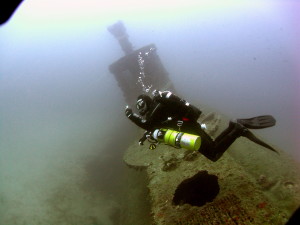 Now we have all been on wrecks – they have either been flattened by rough seas or pillaged for their artefacts. In Malta, if you remove anything from a wreck you can end up in jail, and the skipper and the dive centre that organised your trip could lose their licence. The site is then pretty much closed forever.
Now we have all been on wrecks – they have either been flattened by rough seas or pillaged for their artefacts. In Malta, if you remove anything from a wreck you can end up in jail, and the skipper and the dive centre that organised your trip could lose their licence. The site is then pretty much closed forever.
So in Malta, no one takes anything, so the Southwold totally blew our minds. All the sea dives here are down a shot line so it’s incredibly exciting when you see the wreck appear beneath you. In fact with viz around the thirty metre mark in Malta, you get to see the wreck really quickly.
And what a sight!!! The wreck sits perfectly upright on the bottom and still has two great anti-aircraft guns on her stern pointing to the sky. The ocean floor is littered with unexploded shells and other debris left when she sank. Ascending over her deck you cruise over the guns and across the crew’s quarters. Through the broken and smashed walls you can see the bathrooms and toilets, incredible. The ascent is a blue one and I have never seen such incredible azures. Our time hanging around the shot just melted away into the blue.
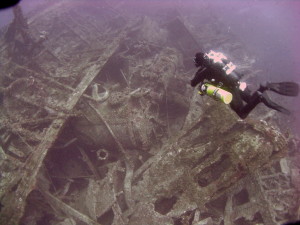 We then decided to do a new Unknown wreck, which was incredible for us as we were among very few divers to have ever dived the site. We reached the Unknown’s deck at 100 metres and thought we were all narced off our heads. It seems that the boat was made of stone; as it turns out, this is a rubble dumping ground from the main land. The sand and stone gave her a ghostly white appearance and as soon as our ten minutes were up we knew we had to come back again and try and find her name. The following day we dropped to 115 metres and attempted to see if we could get her name from the bow. In true tech fashion though we were having so much fun hovering in her upright shadow staring at all the green coral growing from her sides that we never made it there.
We then decided to do a new Unknown wreck, which was incredible for us as we were among very few divers to have ever dived the site. We reached the Unknown’s deck at 100 metres and thought we were all narced off our heads. It seems that the boat was made of stone; as it turns out, this is a rubble dumping ground from the main land. The sand and stone gave her a ghostly white appearance and as soon as our ten minutes were up we knew we had to come back again and try and find her name. The following day we dropped to 115 metres and attempted to see if we could get her name from the bow. In true tech fashion though we were having so much fun hovering in her upright shadow staring at all the green coral growing from her sides that we never made it there.
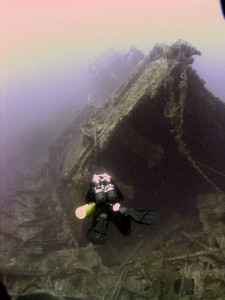 So once again we ascended into the blue to do our decompression schedule. Wet notes were exchanged and it was decided that we had to get back here as soon as possible.
So once again we ascended into the blue to do our decompression schedule. Wet notes were exchanged and it was decided that we had to get back here as soon as possible.
Malta is littered with wonderful sites, from rock structures to caves to wrecks. There is something for everyone there, recreational or technical. And if you are lucky enough o be working with a dive centre as good as Gozo Aqua Sports then you are in for the dives of your life. So get your ass out there, I promise you will not regret it.
Paul is the Director of Training at RAID. To find out more about the courses that RAID offers, visit www.diveraid.com.
News
Book Review: Fire on Monroe Bravo by Fred Lockwood

Fire on Monroe Bravo is the latest book in the Jack Collier series by Fred Lockwood. Our story begins with our lead characters, Jack and Sandro, owners of Marine Salvage & Investigation Company, arriving on the Monroe Bravo Oil & Gas Platform in the North Sea. Having secured a contract for their vessel the MV Stavanger to act as support ship to the platform for TransGlobal Oil, our protagonists are on a celebratory visit.
However almost as soon as they arrive a series of explosions rock the platform, causing huge damage, loss of life and the very real danger of a massive human, ecological and financial disaster.

As the danger mounts for both our heroes and the surviving workers, Jack and Sandro will have to escape the inferno, all while trying to save the platform and the men still trapped unable to help themselves.
The disaster sets the scene for the unfolding story lines following the fate of the platform and our main characters, the police investigation into a suspected terrorist act and the actions of TransGlobal Oil as they attempt to navigate the pubic outcry and financial repercussions.
In his eighth book, Fire on Monroe Bravo, Fred Lockwood delivers an explosive thriller, with plenty of above and in-water drama, and our heroes fighting for survival, what more can you ask for?
We thoroughly recommend this read and look forward to the next in the series. For more information about his book series, you can check out the reviews of his previous books here on Scubaverse.
- Title: Fire On Monroe Bravo
- Author: Fred Lockwood
- ISBN: 979-8325324536
Available in a paperback version and for Kindle from Amazon and book stores.
Blogs
Alonissos: The complete diving destination (Part 1)

In June we were incredibly fortunate to be invited to dive in Alonissos, a small Greek Island in the Sporades island chain located in the North Aegean Sea. While I have long been a big fan of the Greek Islands as a great holiday destination, I had not had the opportunity to do any diving on previous visits and Mike and I were extremely excited to see what Alonissos had to offer both above and below the surface!

The Sporades are easily accessible via the airport in Skiathos (the first island in the chain), which is served by Jet2 flights from all major UK airports from May through October. Numerous ferries and charter boats make island hopping from Skiathos Town a breeze. After an hour boat ride, the picturesque port of Patitiri was a wonderful introduction to Alonissos, where we were met by our gracious hosts Kostas of Albedo Travel and Dias of Alonissos Triton Dive Center. Mike and I were delighted to be staying at the Paradise Hotel, aptly named for its stunning views over the sea and great location for walking to the waterfront.

Alonissos is beautifully situated in the National Marine Park of Alonissos and the Northern Sporades, the largest marine protected area in Europe. The surrounding seas offer fabulous marine life, including incredibly rare species such as the Mediterranean monk seal. They boast deep walls covered in gorgonians and sponges, stunning topography with caverns, swimthroughs and pinnacles, and the first accessible ancient shipwreck from 500BC!

In locations where historical sites have been reported, the waters are largely restricted, but with collaboration between government, underwater archeologists and dive centres, incredible underwater museums are being created for a truly unique diving experience. Alonissos is home to the first of these, the Ancient Shipwreck of Peristera Accessible Underwater Archeological Site. The chance to dive into history (along with reports of healthy reef life and amazing underwater topography) meant Mike and I were keen to get in the water.

Our introduction to the diving around Alonissos was at the Agios Georgios Pinnacles, in the channel between Alonissos and Skopelos. This fantastic site was named “The Chimney,’ and proved to have a huge amount to see. We got to a decent depth here (over 25m), and marvelled at a colourful reef wall with a wonderful swim through whose rocky walls were absolutely covered with life. As well as brilliant topography there was no shortage of macro life here. We saw numerous nudibranchs, five different species in total. The second dive at Mourtias reef nearby was a shallower dive along a nice wall with lots of crevices. Several moray eels and grouper called this site home. We enjoyed looking in the crevices for lobster and smaller benthic life, such as cup corals and tunicates.

Our itinerary allowed us two dives a day with afternoons left to explore the island with our hire car and evenings to enjoy the famous Greek hospitality. This proved to be a lovely mix of in-water and land based diversions.

The next days diving to the Gorgonian Gardens and Triton’s Cave was to be even better! These two stunning sites are nothing short of fabulous. The Gorgonian Gardens was a deep wall near to the Agios Georgios islands. The ever-present currents in this deep channel meant that the sea life was amazing … the namesake Gorgonian sea fans dotted the wall at a depth of 30 to 50 meters, getting ever larger the deeper we went. Above 30m was by no means less beautiful, with sponges, corals, scorpionfish, moray eels and some rare and colourful nudibranchs.

The second shallower dive of the day was to Triton’s Cave or the Cavern of Skopelos, on the east side of that island. The spectacular rock formations had wild striations both above and below the water making a truly epic topography. The cavern entrance was at 14m, and big enough for a buddy pair, winding up to 6m and passing two beautiful windows out into the blue. Emerging from the cavern, the light at the shallower depths and the incredible rock formations made for a fantastic gentle swimming safety stop and we all surfaced by the boat with massive grins.

Check out our next blog :Alonissos: The complete diving destination (Part 2)” to hear about our amazing dive on the 2500 year old Peristera Wreck!
Thanks to:
Alonissos Triton Dive Center https://bestdivingingreece.com/
Albedo Travel https://alonissosholidays.com/activities/
Paradise Hotel https://paradise-hotel.gr/
Alonissos Municipality https://alonissos.gr/en/
-

 Blogs2 months ago
Blogs2 months agoDiving With… Nico, Ocean Earth Travels, Indonesia
-

 News1 month ago
News1 month agoMurex Bangka Announce New Oceanfront Cottages & Beachfront Dining
-

 Blogs2 months ago
Blogs2 months agoA new idea in freediving from RAID
-

 Marine Life & Conservation1 month ago
Marine Life & Conservation1 month agoIceland issue millionaire whale hunter a licence to murder 128 vulnerable fin whales
-

 Marine Life & Conservation2 months ago
Marine Life & Conservation2 months agoThe Shark Trust Great Shark Snapshot is back
-

 News3 months ago
News3 months agoCharting New Waters; NovoScuba Goes Global with the Launch of their Revolutionary Dive Training Agency!
-

 Gear News1 month ago
Gear News1 month agoNew Suunto Ocean – a dive computer and GPS sports watch in one for adventures below and above the surface
-

 Marine Life & Conservation Blogs2 months ago
Marine Life & Conservation Blogs2 months agoBook Review: Plankton


